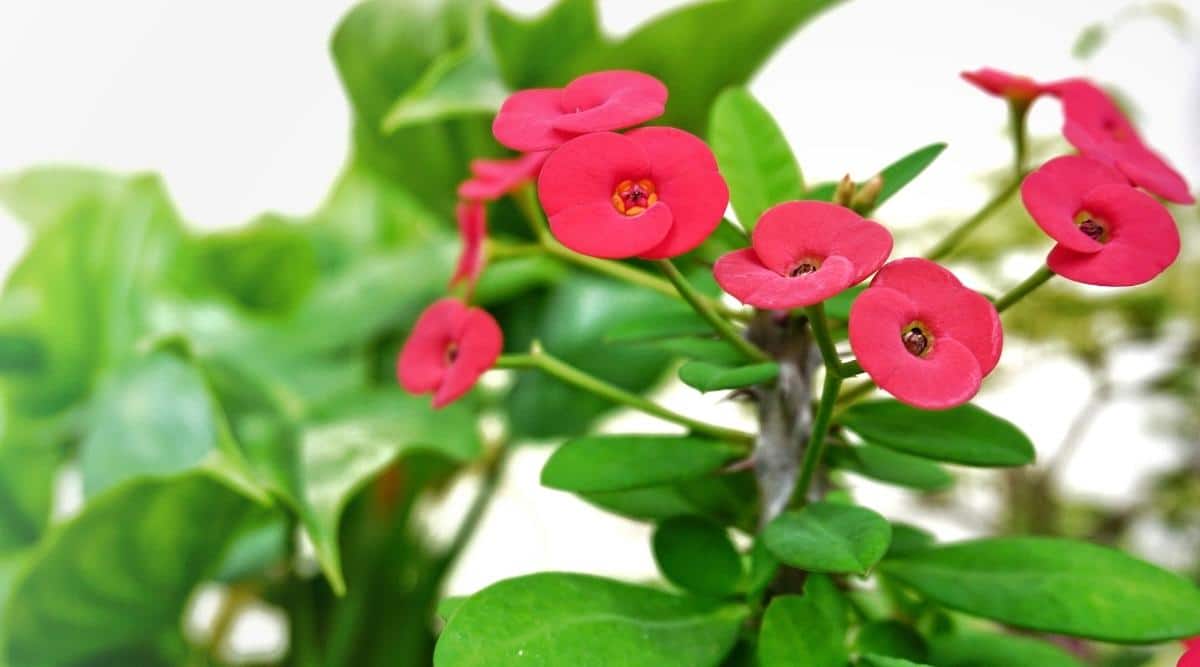modelcampusa.com – The Crown of Thorns (Euphorbia milii) is a striking and resilient succulent known for its bold, colorful blooms and thorny stems. Native to Madagascar, this hardy plant has gained popularity around the world as both an ornamental and houseplant. With its unique combination of vibrant flowers and dramatic, spiny branches, the Crown of Thorns is a captivating addition to any garden or indoor space.
Description and Features
Crown of Thorns is a low-growing shrub that typically reaches heights of 1 to 3 feet, with a similar spread. It is characterized by its thick, succulent stems that are covered with sharp thorns, giving it a thorny crown-like appearance. The plant’s leaves are small, elliptical, and green, often clustered around the base of the stems. However, the most notable feature of the Crown of Thorns is its striking flower-like bracts.
The flowers themselves are small and inconspicuous, but the brightly colored bracts—modified leaves that surround the true flowers—are what make the Crown of Thorns stand out. These bracts can be found in a range of colors, including red, pink, orange, yellow, and white, and they bloom throughout the year, creating a long-lasting display of color. The plant’s flowers are tiny, usually located in the center of each bract, but it is the vibrant bracts that catch the eye and make the plant a favorite among gardeners.
The Crown of Thorns has a tough, hardy nature, making it a perfect choice for those seeking a low-maintenance, drought-tolerant plant. Its spiny appearance and the resilience of its blooms have made it a symbol of strength and endurance in various cultures.
Habitat and Distribution
Native to Madagascar, the Crown of Thorns thrives in dry, tropical environments. It prefers well-drained soil and requires full sun to grow successfully, though it can tolerate some light shade. The plant is highly adaptable and can be grown outdoors in warm, frost-free climates (USDA hardiness zones 9 to 11), where it is often used as a landscaping plant, especially in xeriscapes or desert-themed gardens. It can also be grown as an indoor plant in cooler climates, provided it receives plenty of bright, indirect light.
In outdoor gardens, Crown of Thorns is often used as a hedge, border, or accent plant, where its compact size and year-round blooms create visual interest. Its ability to tolerate dry conditions makes it a perfect choice for low-water landscapes, and its spiny stems provide an added layer of security when used as a barrier plant.
Ecological Importance
Although Crown of Thorns is primarily grown for its ornamental value, it can provide some ecological benefits. The plant’s small flowers attract pollinators like bees, butterflies, and other beneficial insects. The bright colors of the bracts act as a signal to these pollinators, while the plant’s tough, succulent nature helps it survive in challenging environments.
However, it is important to note that the plant’s milky sap contains a toxic compound called diterpene esters, which can be harmful if ingested. While this makes the plant a poor choice for homes with young children or pets, it also acts as a natural deterrent against herbivores, which are less likely to consume the plant.
Cultivation and Care
Crown of Thorns is relatively easy to grow, making it an excellent choice for both novice and experienced gardeners. It thrives in well-drained, sandy or loamy soil and requires little maintenance once established. This drought-tolerant plant can survive long periods without water, making it ideal for gardeners in arid climates or those looking for a low-maintenance indoor plant.
When planting Crown of Thorns, choose a sunny location that receives at least 6 hours of direct sunlight per day. For those growing it indoors, a south-facing window with plenty of sunlight is the best choice. In outdoor gardens, be sure to plant the Crown of Thorns in a location with good drainage to prevent root rot.
Water the plant moderately, allowing the soil to dry out between waterings. During the winter months, reduce watering as the plant enters a dormant phase. Fertilize Crown of Thorns with a balanced, water-soluble fertilizer every few weeks during the growing season to encourage healthy blooms and strong growth.
Although the plant is relatively pest-resistant, it can occasionally be affected by aphids or mealybugs. Regular inspection of the plant will help identify and address any pest issues. Pruning is recommended to remove any dead or damaged branches, as well as to maintain a tidy shape. The thorny stems can be sharp, so it’s important to wear gloves while handling the plant.
Symbolism and Cultural Significance
The Crown of Thorns has a rich cultural and religious significance. In Christian tradition, the plant is associated with the crown of thorns worn by Jesus Christ during his crucifixion, making it a symbol of suffering, sacrifice, and redemption. This deep spiritual connection has led to the plant’s use in religious artwork and symbolism, particularly in the context of Easter and Passion narratives.
In addition to its religious symbolism, the Crown of Thorns is often associated with strength, endurance, and resilience. Its ability to thrive in harsh conditions, combined with its thorny appearance and colorful blooms, makes it a powerful symbol of overcoming adversity.
Conclusion
Crown of Thorns is a unique and striking plant that offers both beauty and resilience. Its vibrant bracts, thorny stems, and ability to thrive in dry conditions make it a favorite for gardeners seeking a bold, low-maintenance addition to their landscapes. Whether grown outdoors in warm climates or as a houseplant in cooler areas, Crown of Thorns provides year-round color and serves as a powerful symbol of strength and endurance. With its rich history, cultural significance, and adaptable nature, this remarkable plant continues to captivate gardeners and plant enthusiasts around the world.
